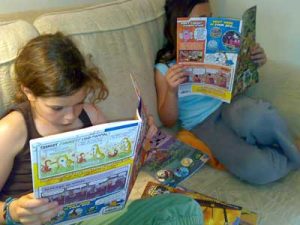Importance of Comics in Education
Comics is an asset in education because of its Motivating power. The ability of comics to motivate students is established long back through Hutchinson’s experiment (1949) with a curriculum built around Puck – the Comic Weekly. In the survey 74% of teachers found comics “helpful for motivation”, while 79% claimed comics “increased individual participation”. Even the advantage of comic books was so disturbing to a teacher that the teacher complained that comic books made “learning too easy”.
 William Marston theorizes that the appeal of the comics medium is woven into the very fabric of its nature. According to Marston, all of humankind have a natural attraction to comics. By inviting comics into their classrooms, educators can take advantage of the “fantastic motivating power of comic books”.
William Marston theorizes that the appeal of the comics medium is woven into the very fabric of its nature. According to Marston, all of humankind have a natural attraction to comics. By inviting comics into their classrooms, educators can take advantage of the “fantastic motivating power of comic books”.
Kay Haugaard, a teacher and a mother of three boys, found that comics were the only way to motivate her sons to read. According to her “The first thing which my oldest boy read because he wanted to was a comic book”. According to some science students, “”Science in Comic Books” provides enough motivation for them to overlook the oversimplification of example problems appropriate for an introductory physics course. Again it is observed by Diamond, an art teacher, that students in her high school art class are consumed by comics-based art projects, despite the many hours such projects usually require.
Comics’ primary advantage over other literary forms is that comics, being composed of “pictorial and other images” are fundamentally a visual medium, where pictures and text shoulder the burden of the story together. Versaci who is a teacher feels that comics can “quite literally ‘put a human face’ on a given subject” resulting in an intimate, emotional connection between his students and characters of a comics story.
In a comparative study between comics and text, W. W. D. Sones (1944), professor of Pittsburgh University, found that comics’ visual quality increases learning. He noted that students of “low and middle intelligence levels” were especially helped by comics’ visual quality. Sones’ conclusions foreshadow the trend towards teaching to multiple intelligences among educators today. In the struggle to engage students of all learning dispositions, comics can prove to be a formidable tool.
Naturally over here a comparison film and animation with comics comes into question. Film and animation, in contrast to comics, are visual but “time-bound.” Language and actions in film and animation are “fleeting.” The medium, rather than the audience, dictates how quickly the viewing progresses. The same is true of a traditional face-to-face lecture; the speaker has primary control over the speed of the lecture. Time within a comic book progresses only as quickly as the reader moves her eyes across the page. The pace at which information is transmitted is completely determined by the reader. The text medium, on the other hand, shares comics’ “permanent” component but not its “visual”. “Visual permanence,” then, is unique to comics. In educational settings, this “visual permanence” firmly places control over the pace of education in the hands (and the eyes) of the student.
Comics can serve as an intermediate step to difficult disciplines and concepts. Comics can lead students towards the discipline of reading, especially those who don’t enjoy reading or have a fear of failure. A study at the University of Pittsburgh supported this suggestion, finding comic books useful in remedial reading instruction. Many teachers “discovered comic strips to be particularly useful in special classes or for slow learning pupils in regular classes”.
The intermediary quality of comics was taken one step further, by Versaci. Using comics, Versaci challenges college literature students to consider, evaluate, and question the very concept of a “literary canon.” Because comics are rarely considered literature, Versaci can surprise his students with well-written comics dealing with mature themes. Versaci then leads his class in a discussion on literary worth. He has found that discussions on comics are generally livelier than those on classic novels, possibly because of a misguided notion that books in the traditional canon are above question. Through comics, Versaci encourages his students to think critically about the literary worth of books and the formation of the literary canon.
Beyond specific works, the very act of creating comics is an interdisciplinary activity. In addition to reading and writing, comics-based projects can develop drawing, computer, and research skills. Many of the skills used in comics creation can be applied to film-making, illustration, and even Web design
American children are steeped in popular culture. While some educators simply ignore this reality, many others struggle to address it adequately. By incorporating popular culture into the curriculum, teachers can bridge the separation many students feel between their lives in and out of school. Teachers can introduce popular culture into their classrooms easily and effectively through comics. Comic books have been a vital part of American popular culture for the last century and blockbuster movieslike Spider-man and Star Wars, both of which have comic book counterparts, are the evidences of this. Through comic books, teachers can lead their students in a study of “contemporary lifestyles, myths, and values”.
The potency of the picture story is not a matter of modern theory but of anciently established truth. Before man thought in words, he felt in pictures… because pictures tell any story more effectively than words.
